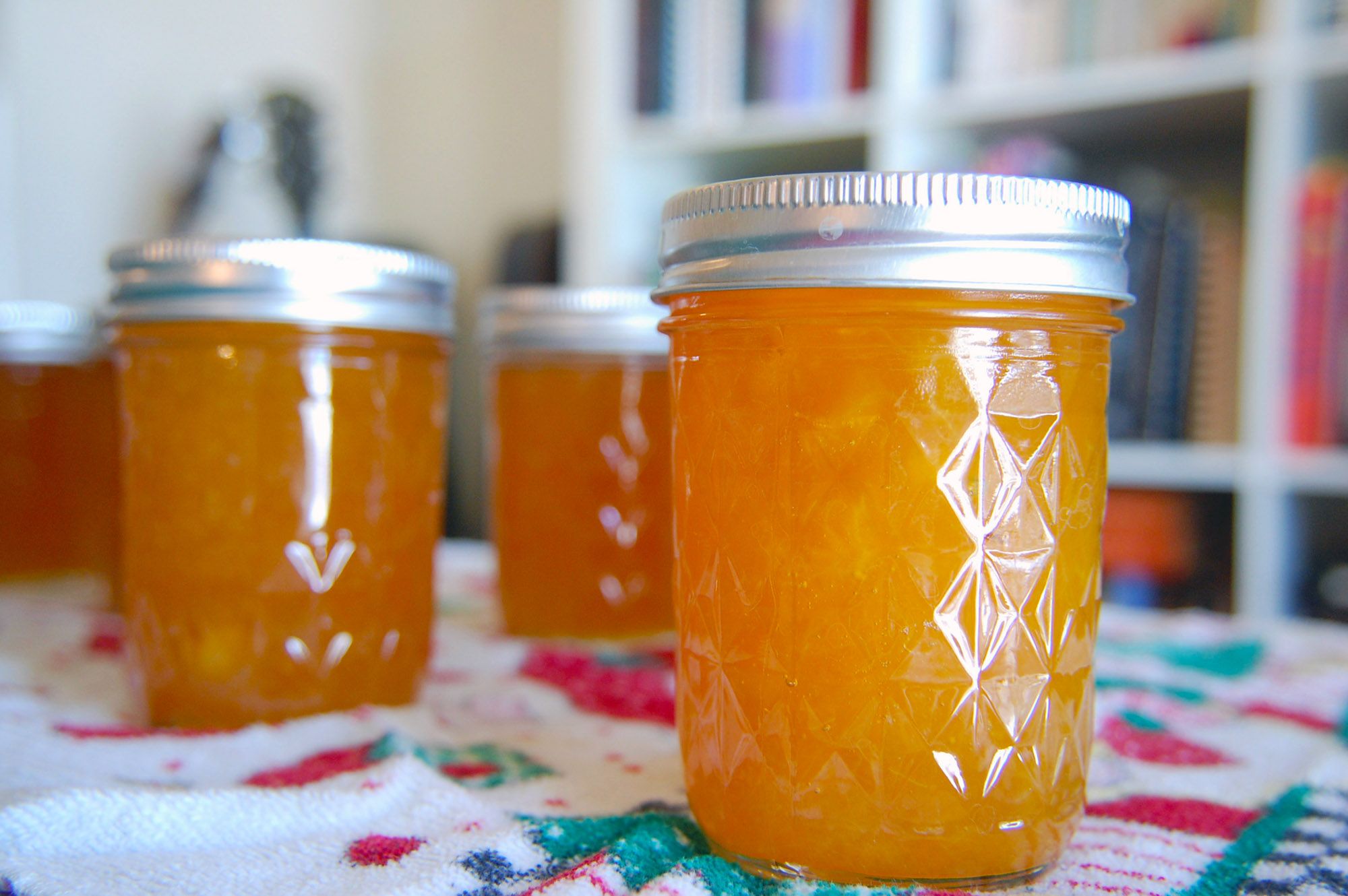Homemade Peach Jam

Peaches have a long growing season, so you have lots of time to use our peach jam recipe and make a whole cupboard-full of delicious peach jam.
Most peaches grow from late May through October. Depending upon the kind of peaches you grow, you'll want to eat some of them fresh, and leave other varieties for your jam-making. In all, there are three different categories of peaches:

Freestone. This type of peach is very aptly named: the stone is easy to free from the peach. Freestones are usually what you see in grocery stores, and are great for fresh eating, canning, jam, baking and freezing. They're generally bigger, sweeter and firmer than clingstones, as well as less drippy. A good all-around peach.
Semi-freestone: This type of peach's pit tends to stick, usually on one side, so it falls somewhere between the freestone and clingstone category. A general all-purpose peach that good for eating and canning. May also be referred to as semi-clingstone.
Clingstone. The pretty yellow peach flesh "clings" to the stone, and therefore the name. These are the earliest peaches to come in. Distinguished by their juiciness and sweet peach flavor, they lend themselves very well to jams, preserves and canning. This is the canned peach you usually see on the supermarket shelf.

Tips to Making the Best Peach Jam:
- Get everything in place before you begin, because there are points in the process where you won’t be able to stop and get what you need.
- Don’t be tempted to increase the spice amounts; you want the peach flavor to shine through.
- Use the amounts below, follow the directions, and your jam will come out perfect every time. Overcooking and using the wrong proportion of ingredients are the main causes of runny jam.
Peach Jam Recipe

You will need:
- 8 cups pitted, peeled* peaches, cut in a 1-inch dice
- A large bowl of ice water
- Zest of half a lemon
- 4 Tablespoons fresh-squeezed lemon juice
- 6 Tablespoons classic fruit pectin
- 7 cups white sugar
- 1 Tablespoon finely chopped crystallized ginger
- 1/4 teaspoon freshly ground nutmeg
- 1/2 teaspoon ground cinnamon
- 1/8 teaspoon ground cloves
- 1/4 teaspoon salt
- Large canning pot with rack
- Jar lifter (typically found in canning sets)
- Large tongs (typically found in canning sets)
- Large ladle
- A wet paper towel
- Dry paper towels
- 6 one-pint (16 oz.) glass canning jars, with lids and screw-on bands


Instructions:
- Get your boiling water going in your canning pot. The water should be two inches over the height of the jars. Heat jars, lids and bands in simmering (not boiling) water until ready to use. Remove with tongs and set on dry paper towels.
- *You can use the same pot to peel your peaches. Cut an X in the bottom of each peach. Drop 4 or 5 at a time into the simmering water for 45 seconds. Immediate remove peaches and drop in a large bowl of ice water for 20-30 seconds. You should easily be able to slip the skin right off the peaches. Repeat this step if the skin is stubborn.
- In a 6- to 8-quart saucepan, set to medium-high heat, bring the peaches and lemon juice to a boil. Lightly mash the peaches (this will help thicken the jam).
- Add the pectin and quickly return the mixture to a boil. Stirring constantly, gradually add the sugar.
- All at once, stir in the crystallized ginger, nutmeg, cinnamon, cloves, reserved lemon zest and salt, and continue to boil, stirring constantly, for 1 minute.
- Remove from heat. Skim any foam off the top.
- Ladle hot jam into hot jars, leaving ¼-inch headspace. Wipe rim with wet paper towel. Center lid on jar. Screw on the band until firmly in place.
- Process in the boiling water bath 10 minutes. Remove jars and cool. Check lids after 24 hours; they should not flex when center is pressed.
- Label and date your jars. Peach jam will keep up to two years.
Makes 6 pints.

Grow Your Own Peach Trees
 On Sale
On Sale
 This variety is compatible with your location
This variety is compatible with your location
 On Sale
This variety is compatible with your location
On Sale
This variety is compatible with your location
 On Sale
This variety is compatible with your location
On Sale
This variety is compatible with your location
 On Sale
On Sale
 This variety is compatible with your location
This variety is compatible with your location
 On Sale
This variety is compatible with your location
On Sale
This variety is compatible with your location
 This variety is compatible with your location
This variety is compatible with your location


